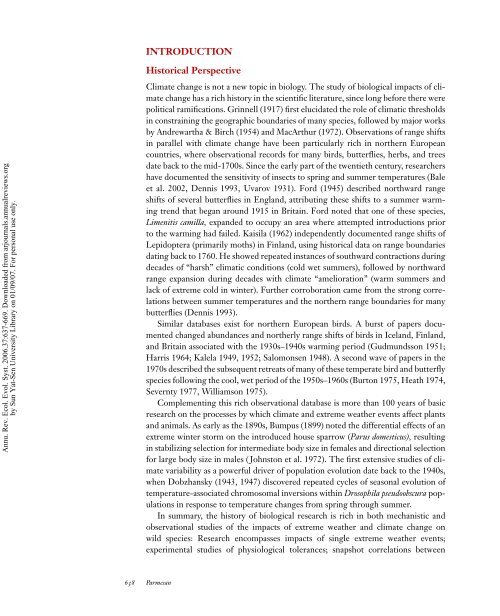Ecological and Evolutionary Responses to Recent Climate Change
Ecological and Evolutionary Responses to Recent Climate Change
Ecological and Evolutionary Responses to Recent Climate Change
You also want an ePaper? Increase the reach of your titles
YUMPU automatically turns print PDFs into web optimized ePapers that Google loves.
INTRODUCTION<br />
His<strong>to</strong>rical Perspective<br />
Annu. Rev. Ecol. Evol. Syst. 2006.37:637-669. Downloaded from arjournals.annualreviews.org<br />
by Sun Yat-Sen University Library on 01/09/07. For personal use only.<br />
<strong>Climate</strong> change is not a new <strong>to</strong>pic in biology. The study of biological impacts of climate<br />
change has a rich his<strong>to</strong>ry in the scientific literature, since long before there were<br />
political ramifications. Grinnell (1917) first elucidated the role of climatic thresholds<br />
in constraining the geographic boundaries of many species, followed by major works<br />
by Andrewartha & Birch (1954) <strong>and</strong> MacArthur (1972). Observations of range shifts<br />
in parallel with climate change have been particularly rich in northern European<br />
countries, where observational records for many birds, butterflies, herbs, <strong>and</strong> trees<br />
date back <strong>to</strong> the mid-1700s. Since the early part of the twentieth century, researchers<br />
have documented the sensitivity of insects <strong>to</strong> spring <strong>and</strong> summer temperatures (Bale<br />
et al. 2002, Dennis 1993, Uvarov 1931). Ford (1945) described northward range<br />
shifts of several butterflies in Engl<strong>and</strong>, attributing these shifts <strong>to</strong> a summer warming<br />
trend that began around 1915 in Britain. Ford noted that one of these species,<br />
Limenitis camilla, exp<strong>and</strong>ed <strong>to</strong> occupy an area where attempted introductions prior<br />
<strong>to</strong> the warming had failed. Kaisila (1962) independently documented range shifts of<br />
Lepidoptera (primarily moths) in Finl<strong>and</strong>, using his<strong>to</strong>rical data on range boundaries<br />
dating back <strong>to</strong> 1760. He showed repeated instances of southward contractions during<br />
decades of “harsh” climatic conditions (cold wet summers), followed by northward<br />
range expansion during decades with climate “amelioration” (warm summers <strong>and</strong><br />
lack of extreme cold in winter). Further corroboration came from the strong correlations<br />
between summer temperatures <strong>and</strong> the northern range boundaries for many<br />
butterflies (Dennis 1993).<br />
Similar databases exist for northern European birds. A burst of papers documented<br />
changed abundances <strong>and</strong> northerly range shifts of birds in Icel<strong>and</strong>, Finl<strong>and</strong>,<br />
<strong>and</strong> Britain associated with the 1930s–1940s warming period (Gudmundsson 1951;<br />
Harris 1964; Kalela 1949, 1952; Salomonsen 1948). A second wave of papers in the<br />
1970s described the subsequent retreats of many of these temperate bird <strong>and</strong> butterfly<br />
species following the cool, wet period of the 1950s–1960s (Bur<strong>to</strong>n 1975, Heath 1974,<br />
Severnty 1977, Williamson 1975).<br />
Complementing this rich observational database is more than 100 years of basic<br />
research on the processes by which climate <strong>and</strong> extreme weather events affect plants<br />
<strong>and</strong> animals. As early as the 1890s, Bumpus (1899) noted the differential effects of an<br />
extreme winter s<strong>to</strong>rm on the introduced house sparrow (Parus domesticus), resulting<br />
in stabilizing selection for intermediate body size in females <strong>and</strong> directional selection<br />
for large body size in males ( Johns<strong>to</strong>n et al. 1972). The first extensive studies of climate<br />
variability as a powerful driver of population evolution date back <strong>to</strong> the 1940s,<br />
when Dobzhansky (1943, 1947) discovered repeated cycles of seasonal evolution of<br />
temperature-associated chromosomal inversions within Drosophila pseudoobscura populations<br />
in response <strong>to</strong> temperature changes from spring through summer.<br />
In summary, the his<strong>to</strong>ry of biological research is rich in both mechanistic <strong>and</strong><br />
observational studies of the impacts of extreme weather <strong>and</strong> climate change on<br />
wild species: Research encompasses impacts of single extreme weather events;<br />
experimental studies of physiological <strong>to</strong>lerances; snapshot correlations between<br />
638 Parmesan
















